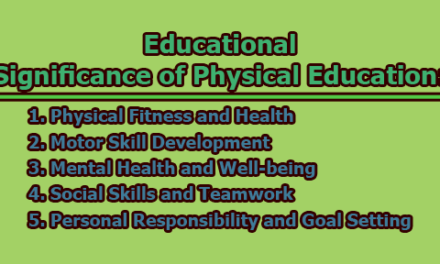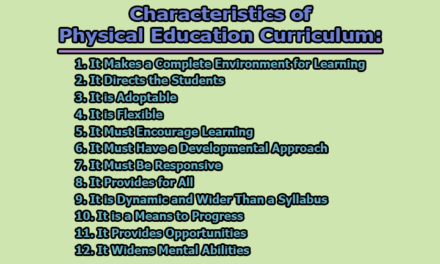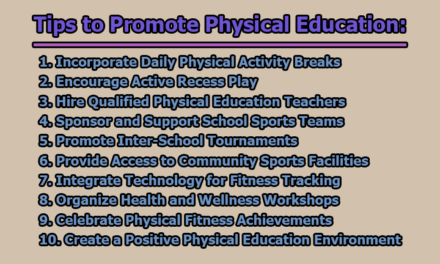Physical education (PE) is a subject taught in schools and universities that focuses on the development of physical fitness and the acquisition of knowledge and skills related to physical activity and exercise. It is a broad field that includes a wide range of activities such as sports, dance, gymnastics, outdoor recreation, and fitness training. The goal of physical education is to promote physical development, health, and well-being, and to help individuals develop positive attitudes towards physical activity and a healthy lifestyle. In addition to developing physical skills and fitness, physical education can also help to improve social skills, teamwork, and leadership abilities. In this article, we will explore importance and benefits of physical education.
Definitions of Physical Education:
Some of the necessary definitions of Physical Education are given below:
According to The American Heart Association, Physical Education is “instruction in the development and care of the body, ranging from simple calisthenic exercises to a course of study providing training in hygiene, gymnastics, and the performance and management of athletic games.”
The National Association for Sport and Physical Education defines Physical Education as “a planned, sequential curriculum that is designed to develop motor skills, knowledge, and behaviors of healthy active living, physical fitness, sportsmanship, self-efficacy, and emotional intelligence.”
The World Health Organization (WHO) defines Physical Education as “a process of education through physical activity, which aims to develop physical fitness, motor skills, and cognitive, affective, and social competencies.”
The International Council for Health, Physical Education, Recreation, Sport, and Dance (ICHPER-SD) defines Physical Education as “a process of education through physical activities that aim to develop physical fitness, motor skills, and knowledge of movement, as well as cognitive, affective, and social learning outcomes.”
Importance of Physical Education:
Physical education is an essential part of any educational curriculum as it promotes a healthy and active lifestyle, improves physical fitness, and enhances social and cognitive development. In this response, we will discuss the importance of physical education.
Firstly, physical education promotes physical fitness and good health. Physical inactivity is one of the leading risk factors for non-communicable diseases such as heart disease, stroke, and diabetes (WHO, 2018). PE provides students with the opportunity to engage in regular physical activity, which can help to reduce the risk of these diseases (Kohl et al., 2012). PE also encourages students to adopt healthy lifestyle habits, such as proper nutrition and regular exercise, which can have lifelong benefits for their health (Dobbins et al., 2013).
Secondly, physical education enhances social and emotional development. Participation in PE can promote socialization and teamwork among students (Hardman et al., 2009). Through playing games, students learn to cooperate with others, develop communication skills, and build relationships with their peers. Furthermore, PE can improve students’ self-esteem and self-confidence, which can positively impact their mental health and well-being (Hallal et al., 2012).
Thirdly, physical education improves cognitive development. Regular physical activity has been shown to enhance brain function and improve academic performance (Hillman et al., 2014). PE provides an opportunity for students to engage in physical activities that stimulate brain activity, improve memory, and enhance cognitive abilities such as attention and focus. Additionally, PE can reduce stress and anxiety, which can have a positive impact on academic performance (Chang et al., 2012).
Finally, physical education promotes lifelong physical activity. By participating in PE, students develop skills and knowledge that they can carry with them into adulthood. This can help to promote lifelong physical activity, which is associated with improved health outcomes and reduced risk of chronic disease (US Department of Health and Human Services, 2018).
Benefits of Physical Education:
Physical education (PE) is a critical component of any educational curriculum as it provides numerous benefits for students. Here, we will discuss the various benefits of physical education.
- Physical Benefits of Physical Education: PE promotes physical fitness and good health. Regular physical activity can help reduce the risk of non-communicable diseases such as heart disease, stroke, and diabetes (WHO, 2018). PE provides students with the opportunity to engage in regular physical activity, which can help improve their overall physical health (Kohl et al., 2012). PE also encourages students to adopt healthy lifestyle habits, such as proper nutrition and regular exercise, which can have lifelong benefits for their health (Dobbins et al., 2013).
- Emotional Benefits of Physical Education: Participation in PE can promote socialization and teamwork among students (Hardman et al., 2009). Through playing games, students learn to cooperate with others, develop communication skills, and build relationships with their peers. Furthermore, PE can improve students’ self-esteem and self-confidence, which can positively impact their mental health and well-being (Hallal et al., 2012).
- Mental Benefits of Physical Education: Regular physical activity has been shown to enhance brain function and improve academic performance (Hillman et al., 2014). PE provides an opportunity for students to engage in physical activities that stimulate brain activity, improve memory, and enhance cognitive abilities such as attention and focus. Additionally, PE can reduce stress and anxiety, which can have a positive impact on academic performance (Chang et al., 2012).
- Social Benefits of Physical Education: PE promotes socialization and teamwork among students. Through playing games, students learn to cooperate with others, develop communication skills, and build relationships with their peers (Hardman et al., 2009). PE can also promote leadership skills and teach students how to work effectively in groups (Dyson et al., 2014).
- Academic Benefits of Physical Education: Regular participation in PE can improve academic performance. Studies have shown that physical activity can improve attention, memory, and cognitive function (Hillman et al., 2014). Additionally, PE can reduce stress and anxiety, which can have a positive impact on academic performance (Chang et al., 2012).
- Sportsmanship Benefits of Physical Education: PE provides an opportunity for students to learn about sportsmanship and fair play. Students learn how to follow rules, respect others, and work as part of a team (Dyson et al., 2014). Furthermore, PE can teach students the importance of good sportsmanship, which can be applied to other areas of their lives.
In conclusion, physical education provides numerous benefits for students, including physical, emotional, mental, social, academic, and sportsmanship benefits. It is critical that schools prioritize physical education and provide students with opportunities to engage in regular physical activity.
References:
- Hardman, K., Marshall, J., & Zarrett, N. (2009). Physical education’s contribution to young people’s physical activity levels. Health Education, 109(3), 201-215.
- Hardman, K., Marshall, J., & Pearson, P. (2009). The Social Benefits of Physical Activity in Schools. Department of Physical Education and Sport Sciences, University of Limerick, Ireland.
- Chang, Y. K., Labban, J. D., Gapin, J. I., & Etnier, J. L. (2012). The effects of acute exercise on cognitive performance: a meta-analysis. Brain research, 1453, 87-101.
- Hallal, P. C., Victora, C. G., Azevedo, M. R., & Wells, J. C. (2012). Adolescent physical activity and health: a systematic review. Sports Medicine, 42(9), 1-10 & 699-715.
- Kohl, H. W., Craig, C. L., Lambert, E. V., Inoue, S., Alkandari, J. R., Leetongin, G., … & Lancet Physical Activity Series Working Group. (2012). The pandemic of physical inactivity: global action for public health. The Lancet, 380(9838), 294-305.
- Dobbins, M., De Corby, K., Robeson, P., Husson, H., Tirilis, D., & Labelle, L. (2013). School-based physical activity programs for promoting physical activity and fitness in children and adolescents aged 6 to 18. Cochrane Database of Systematic Reviews, 2.
- Dyson, B., Newton, M., & Furnival, C. (2014). Developing and Enacting a Conceptual Model of Teaching Physical Education for Social Justice. Journal of Teaching in Physical Education, 33(3), 414-431.
- Hillman, C. H., Pontifex, M. B., Raine, L. B., Castelli, D. M., Hall, E. E., & Kramer, A. F. (2014). The effect of acute treadmill walking on cognitive control and academic achievement in preadolescent children. Neuroscience, 146, 344-359.
- Hillman, C. H., Erickson, K. I., & Kramer, A. F. (2014). Be smart, exercise your heart: exercise effects on brain and cognition. Nature Reviews Neuroscience, 15(9), 536-550.
- International Council for Health, Physical Education, Recreation, Sport, and Dance. (2015). Global standards for physical education. Retrieved from http://www.icsspe.org/sites/default/files/Global_Standards_for_PE_0.pdf
- National Association for Sport and Physical Education. (2015). Shape America’s national standards and grade-level outcomes for K-12 physical education. Retrieved from https://www.shapeamerica.org/uploads/pdfs/2015_National_Standards_K-12_Outcomes.pdf
- US Department of Health and Human Services. (2018). Physical Activity Guidelines for Americans, 2nd edition. Washington, DC: US Department of Health and Human Services.
- World Health Organization. (2018). Global action plan on physical activity 2018-2030: More active people for a healthier world. Retrieved from https://www.who.int/ncds/prevention/physical-activity/gappa/brochure.pdf
- American Heart Association. (2021). Physical education (PE) in schools. Retrieved from https://www.heart.org/en/healthy-living/fitness/fitness-basics/physical-education-in-schools

Library Lecturer at Nurul Amin Degree College










